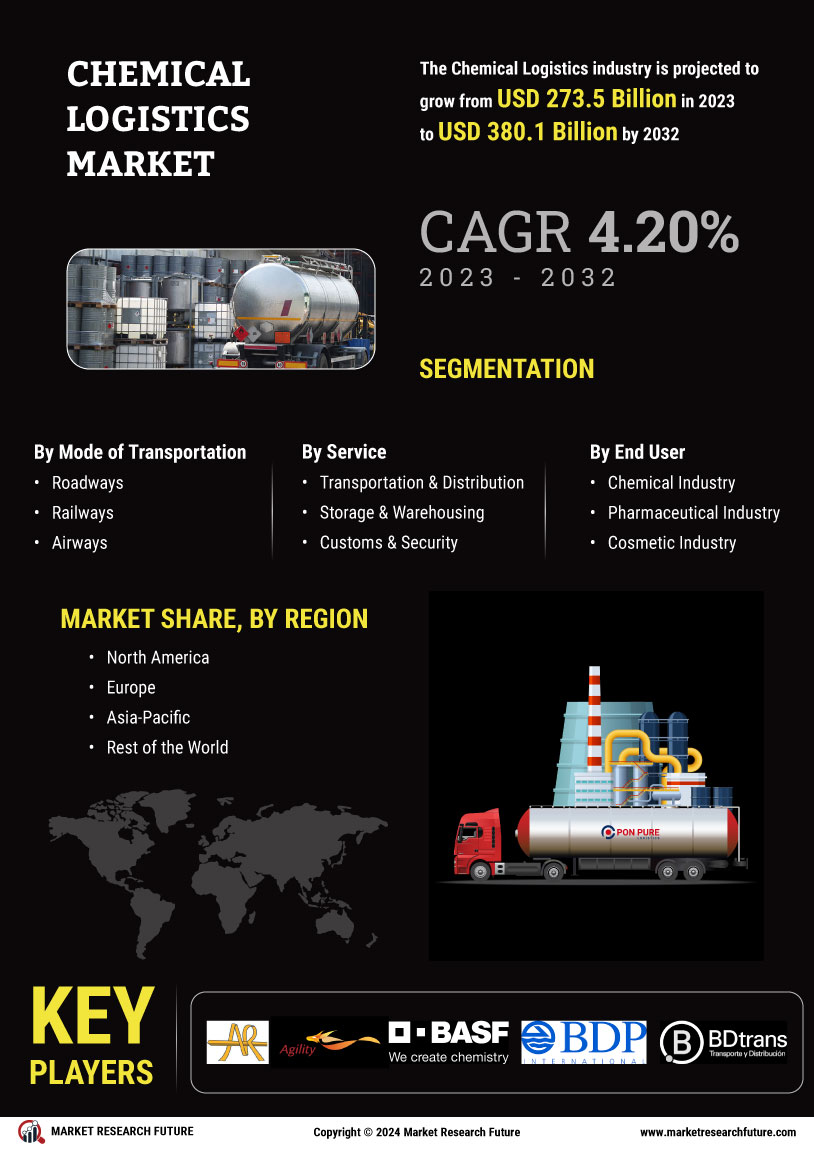Global Chemical Logistics Service types Insights
By Service Types, Chemical Logistics (3PL) market was segmented into Transportation Management, Warehousing and Distribution, Customs Brokerage and Compliance, Specialized Services, and Value-Added Services. The chemical logistics market, particularly within the Transportation Management segment, is poised for steady growth from 2024 to 2032, driven by various factors across different transport subtypes. In 2024, the market for Transportation Management in chemical logistics is projected to reach $99.67 billion, with expectations to grow to $159.81 billion by 2032, reflecting a Compound Annual Growth Rate (CAGR) of 4.39%.
This growth is supported by increasing global trade, advancements in supply chain technologies, and the rising complexity of chemical transportation needs.
Figure 1: Chemical Logistics Market, by Service Type, 2023 & 2032 (USD Billion)

Global Chemical Logistics Chemical Type Insights
By Chemical Type, market is segmented into Basic Chemicals, Specialty Chemicals, Agrochemicals, Pharmaceutical Chemicals, Petrochemicals, Other Types. Basic chemicals, also known as commodity chemicals, are produced in large quantities and serve as the building blocks for various chemical processes and products. This category includes both inorganic and organic chemicals. Inorganic chemicals consist of acids, alkalis, salts, and other compounds used in various industries such as manufacturing, agriculture, and water treatment. Organic chemicals, on the other hand, are primarily derived from petrochemical feedstocks, such as ethylene, propylene, and methanol, which are essential for producing plastics, synthetic rubber, and other materials.
The demand for basic chemicals is primarily driven by their widespread use across multiple sectors, including construction, automotive, textiles, and consumer goods. Growing urbanization and industrialization, especially in developing regions like Asia-Pacific, are significant factors propelling demand for these chemicals. Additionally, the rising need for sustainable products and materials is pushing innovation in the production of eco-friendly organic chemicals, thereby stimulating demand in this segment. In 2023, the global market size for basic chemicals is estimated to be around USD 1.2 trillion, driven by a robust increase in demand from sectors such as manufacturing, automotive, and consumer goods.
Top logistics companies providing services to this segment include Maersk Logistics, Expeditors, CH Robinson, and Kuehne + Nagel, which offer transportation, warehousing, bulk handling, and regulatory compliance services. The compound annual growth rate (CAGR) for basic chemicals logistics is projected to be around 4.37% from 2024 to 2033, driven by rapid industrialization and increasing consumer demand worldwide.
Global Chemical Logistics End Use Insights
By End-Use, market is segmented into Agriculture, Pharmaceuticals, Manufacturing, Oil and Gas, Food and Beverage, Consumer Goods, Other End-Use. The agriculture sector is a foundational pillar in the Chemical Logistics Market, necessitating the extensive use of agrochemicals like fertilizers, pesticides, and herbicides. As the global population expands, the demand for food production intensifies, directly correlating with the need for agrochemicals. In 2023, the market for chemical logistics in agriculture was valued at USD 27.29 Billion and is projected to grow to USD 28.10 Billion in 2024, ultimately reaching USD 37.39 Billion by 2032.
The sector is expected to grow at a steady CAGR of 3.63% from 2024 to 2032. This growth is primarily driven by the ongoing need to enhance agricultural productivity and meet global food security demands. Agrochemicals are critical for optimizing crop yields, making their timely and efficient transportation essential. The logistics involved require specialized handling, storage, and transportation capabilities to prevent contamination and maintain the effectiveness of these chemicals. Furthermore, the shift towards sustainable farming practices is expected to spur the demand for bio-based agrochemicals, further complicating logistics requirements.
Regionally, Asia-Pacific is a significant market for agricultural chemicals due to its large agricultural base, followed by North America and South America. The focus on enhancing supply chain efficiency, coupled with stringent environmental regulations, will shape the future logistics strategies in this sector.










